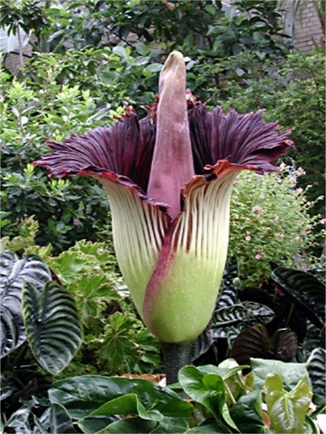I had some technical difficulties with the Weebly site yesterday, so this post got a little delayed. If those problems were totally solved, however, i'm not completely sure. Let's hope for the best!
This gigantic flower appealed to me because of its unusual Portuguese name ("Flor Cadáver"), but in English it is commonly known as the Titan Arum. The corpse reference is due to the incredibly nauseating smell it emits during flowering. Scientists claim it resembles rotting flesh, which is pretty disgusting. The flowering, however, is such a rare and unpredictable event that entire communities gather to see it (despite the horrible smell, I suppose)! Because of this type of blooming, it is considered a fickle flower. Its other name, Titan Arum, is also correct: the flowering structure rises up to three metres above the ground and it also has a single immense leaf. Certainly is a giant among plants!
It dwells in the rainforests of western Sumatra, in the Indonesian archipelago, on steep hillsides that are 120 to 365 metres above sea level and it's classified as Vulnerable on the 1997 IUCN Red List of Threatened Plants. I wonder if they used to be destroyed because of their stench! =P This plant can be used for ornamental displays and is an immensely popular visitor attraction.
This gigantic flower appealed to me because of its unusual Portuguese name ("Flor Cadáver"), but in English it is commonly known as the Titan Arum. The corpse reference is due to the incredibly nauseating smell it emits during flowering. Scientists claim it resembles rotting flesh, which is pretty disgusting. The flowering, however, is such a rare and unpredictable event that entire communities gather to see it (despite the horrible smell, I suppose)! Because of this type of blooming, it is considered a fickle flower. Its other name, Titan Arum, is also correct: the flowering structure rises up to three metres above the ground and it also has a single immense leaf. Certainly is a giant among plants!
It dwells in the rainforests of western Sumatra, in the Indonesian archipelago, on steep hillsides that are 120 to 365 metres above sea level and it's classified as Vulnerable on the 1997 IUCN Red List of Threatened Plants. I wonder if they used to be destroyed because of their stench! =P This plant can be used for ornamental displays and is an immensely popular visitor attraction.
~Ally

 RSS Feed
RSS Feed